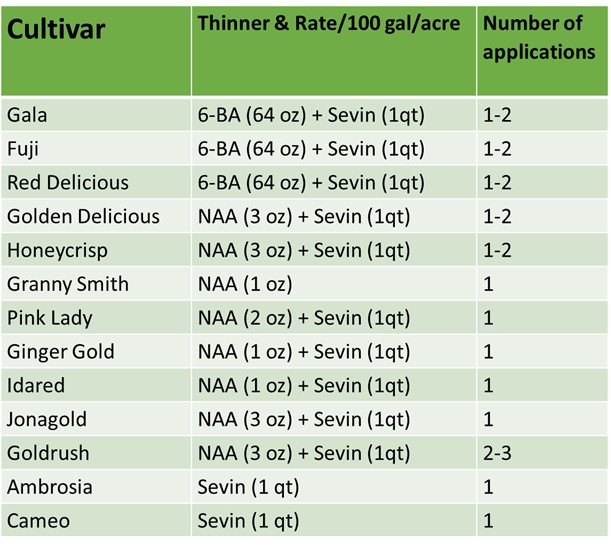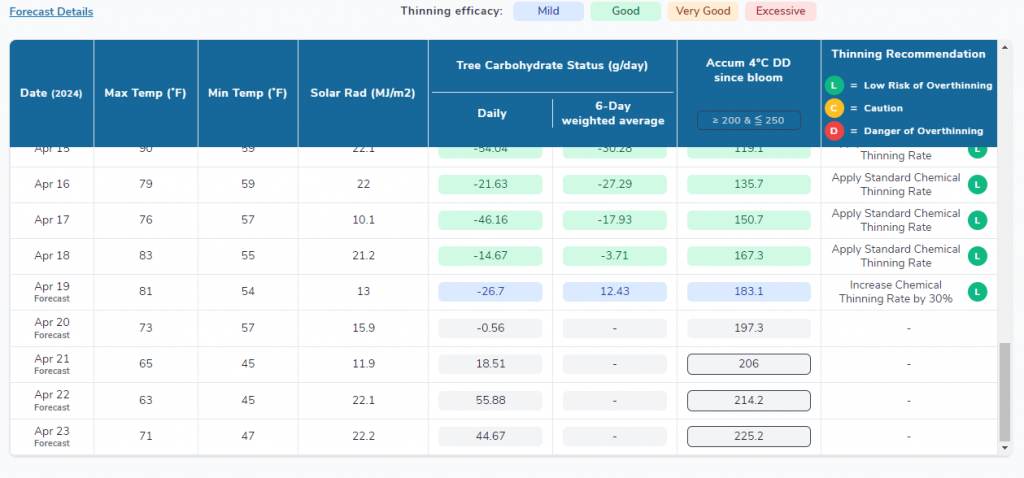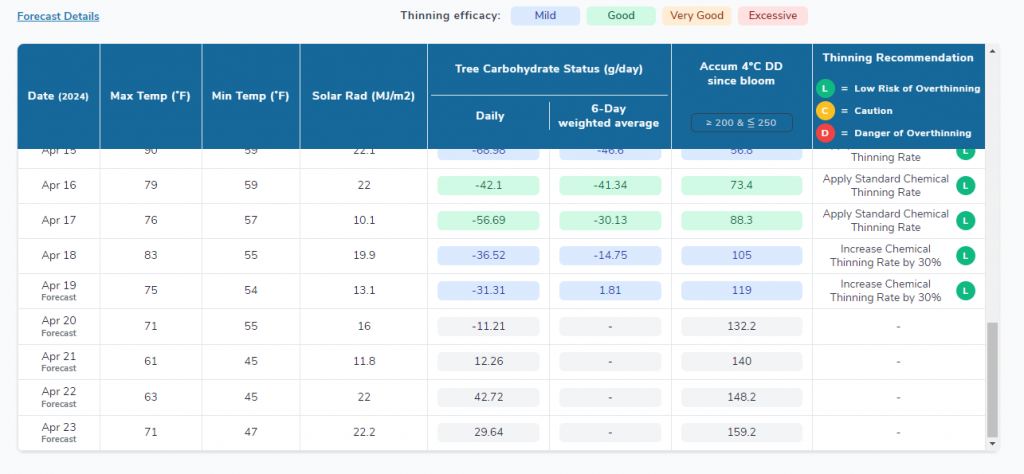In various parts of Virginia, apple orchards are currently transitioning through stages ranging from full bloom and petal fall to having fruits about 6-18 mm in size. Given this period of active growth, it’s an ideal time to discuss the crucial practice of apple fruit thinning—especially vital this year due to the heavy bloom and minimal spring frost damage. Proper thinning is essential; without it, the excess blossoms and small fruitlets from this year could negatively impact both next year’s yield and the quality of this year’s harvest. The development of next year’s flowering buds in apples is largely determined during the first four to five weeks post-full bloom. In years with heavy bloom and fruit set, like this one, failing to adequately thin can lead to too many fruits drawing on the tree’s carbohydrates. This overburden can drastically reduce the number of viable buds for the following year, potentially resulting in no crop for varieties prone to alternate bearing, such as Honeycrisp, Fuji, and Winesap.
Moreover, maintaining too many fruits on the tree can also degrade fruit size and overall quality at harvest—particularly for the Gala variety. It’s important to note that fruit size at harvest is primarily influenced by the rate of cell division and the total number of cells per fruit, rather than merely by cell expansion. This cell division occurs mainly in the initial weeks following full bloom, making it critical to reduce competition among the fruitlets so that more resources are directed to fewer fruits, thus enhancing their growth and quality.
With these points in mind, I’d like to offer some specific recommendations for thinning applications at petal fall and the 6-18 mm fruit size window (the main thinning window). At the end of this post, I will also share outputs from the Carbohydrate Thinning Model and my personal advice for apple growers in Central Virginia and other regions currently within the 6-18 mm fruit size stage. For those in the Winchester and Frederick County areas, where orchards are still transitioning between full bloom and petal fall, other posts will follow as needed.
Effective thinning sprays at petal fall to 5 mm fruit diameter.

Notes:
• To prevent the formation of pygmy fruit, avoid applying NAD and NAA to Red Delicious and Fuji apples after petal fall.
• When using NAD as a thinning spray, ensure that the spray volume is at least 100 gallons per acre, as lower spray volumes may decrease efficacy.
• Carbaryl can be used alone as a thinning spray between petal fall and when the fruit diameter reaches 15 mm. However, it is more commonly used in combination with either NAA or 6-BA when the fruit diameter is between 7 and 15 mm.
• When using carbaryl alone, increasing the rate of application will not enhance thinning activity, as carbaryl’s effectiveness is not highly responsive to changes in application rate.
Recommended chemical materials and rates for thinning fruits (6-15 mm)

Notes:
• Exilis 9.5 SC contains a high concentration of 6-BA (9.51%) compared to Maxcel (1.9%) and Exilis Plus (2%). Refine is available in two concentrations: Refine 3.5 and Refine 6.25, with the latter having a higher concentration of NAA. All dosages in the table are based on the concentrations found in Maxcel (6-BA) and PoMaxa (NAA).
• The recommended application rates in the table are for mature trees (6 years or older). For younger trees (4th and 5th leaf), reduce the rate by 25% to 50%.
• Do not use less than 100 gallons per acre for thinning treatments.
• Thinning is more difficult in the upper parts of the canopy compared to the lower parts.
• Thinning is easier when the crop is heavy, as opposed to when the crop is light.
• Use the carbohydrate thinning model to time your thinning applications. Alternatively, as a general rule of thumb: Thinning is more challenging when it is sunny; overcast conditions for 2 to 3 days facilitate easier thinning; thinning materials are less effective in cool weather (below 65°F) and more effective in warm weather (above 70°F).
Apple Carbohydrate Thinning Model Outputs-Pink Lady- Roseland-VA
The Carbohydrate Thinning Model uses critical environmental factors such as temperature and solar radiation to assess the carbohydrate status of trees. This status helps determine how trees will respond to chemical thinning agents. When trees are in a carbohydrate-deficient state, they are more likely to shed fruit, making them more receptive to thinning applications. Conversely, when conditions are favorable for photosynthesis—sunny and warm—trees are less likely to respond to thinning as they prefer to retain their fruits. Remember, fruits carry seeds, and seeds represent the future generation of trees—an easy concept to grasp. The model doesn’t rely on a single day’s data; instead, it averages the carbohydrate balance over six days to decide if a tree has a deficiency or surplus. This helps determine whether to apply treatments, how much response to expect from the trees, and whether to adjust the quantity of thinning materials to avoid over- or under-thinning. The model also tracks accumulated degree hours from the time of bloom, which is why knowing the exact day of full bloom is crucial. It predicts the optimal thinning period, which usually occurs between 200 to 250 degree days (DD)—coinciding nearly perfectly with the 6-18 mm fruit size window.
Based on data from the weather station in Roseland, VA, and the growth stages of Pink Lady and Gala apples, the model predicts that by Saturday, April 20, Pink Lady trees will reach about 200DD. This is the ideal time to start applying thinning materials, continuing through the 250 DD mark. However, the model also indicates a carbohydrate surplus on April 19 and the following three days. Therefore, it recommends increasing the thinning material rate by 30% above standard. Since the forecast predicts temperatures above 70°F this Saturday, which enhances the uptake and efficiency of agents like NAA and 6-BA, thinning applications are best done on that day.

For Gala apples, which reached green tip on March 12 and full bloom on April 12, the 200-250DD window has not yet been reached. Nonetheless, if you wish to apply chemical thinning now using 6-BA and carbaryl to promote cell division, you can use 48 fl oz of 6-BA and 1 pt/100 gal of carbaryl. However, it’s important to wait at least 10 days to observe the effects of this treatment before proceeding with another. Based on the current weather forecast and degree days, the 6-18 mm fruit size window should still be open in 10 days if you decide on a second thinning application.


